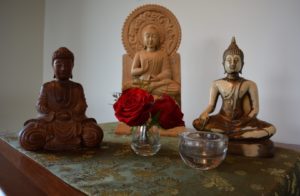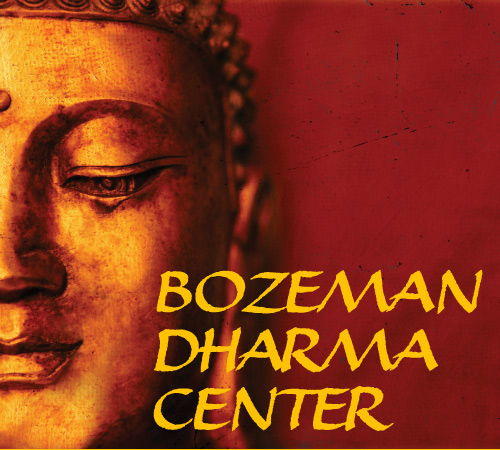Welcome!

It can be intimidating to check out something for the first time! To help newcomers, we’ve gathered resources and information about the Bozeman Dharma Center (BDC) and Buddhism that may be helpful. Click on any of the questions below to take you to the answer.
Questions about the BDC
Where is BDC located?
The Bozeman Dharma Center is located at 3810 Valley Commons Dr.
How do I get in?
Please use the building’s main entrance and then go upstairs by elevator or stairs and turn to your left. We are tucked away in the corner.
Do I need to bring a cushion?
The Dharma Center has many zafu cushions, mats, some meditation benches and chairs. If you have a cushion you would prefer to use, you may bring it along with Crazy Creek-style camp chairs or back-jack supports to lean on during talks and discussions.
May I bring food and drinks?
Most events at the BDC provide tea or water. Often retreats will have some light snacks available. Lunch for day-long events/retreats is usually not provided. Please enjoy food in the foyer, but do not bring it into the meditation hall. Water and herbal tea are okay in the hall in closable containers. Note that this changes when Gallatin County is in a state of high COVID transmission.
What should I wear?
We suggest casual, loose and comfortable clothing. Shoes are not worn in the meditation hall; please leave them on the shoe racks provided by the front door.
What NOT to wear?
Please avoid wearing scented products even ”natural” and “herbal” ones! This includes shampoos and conditioners and clothing that has been washed in fragranced detergent. People with fragrance sensitivities are attending and will need this support from all of us in order to be in the room. We aim for a fragrance free meditation hall. THANK YOU!
Where can I put my belongings?
Shoes and coats can be left in the foyer or lobby of the BDC. Other personal belongings may be left with your shoes/coat or brought into the meditation hall.
Is there a policy for electronic devices?
We ask that all cell phones and other electronic devices be muted while you are at the BDC and preferably kept out of the meditation hall.
Do I need to bow?
Many people bow as they enter the meditation hall as a sign of respect. Different groups have different forms to enter and exit the hall. Individuals in these groups will be happy to instruct you on their forms. You do not have to bow if you do not want to.
Can anyone check out a book?
Yes, the lending library is available for all to use. Please write your name, the date, and the title of the book that you are checking out on the sign out sheet located on a small table near the door. We ask that you try to return the books within 4 weeks. The return basket is on the bottom shelf of the sign-in sheet table. Please use the sign-in sheet to tell us what book you’ve returned.
Suggestions for out of town visitors?
Bozeman is a booming place and it can be overwhelming to figure out where to stay and eat. We’ve compiled a list of our favorites here.
What is dana?
Dana is a voluntary, anonymous offering of no specified amount. The teachings are considered priceless and are offered freely and in return we support the teachers with dana. The Bozeman Dharma Center does not pay any of the visiting teachers who lead our retreats and classes. If you are able, please offer whatever amount feels right to you given your circumstances and brings you joy. It’s a beautiful, time-honored way to support teachers, pay the gift of their teachings forward and sustain the unfolding of wisdom and compassion in our world. We have more information about dana here.
Do I have to give dana if I’ve already paid for the retreat or class?
Unfortunately, it depends:
- When we have a visiting teacher, Dana is a separate offering from the registration fee. The amount you contribute for registration helps cover the expenses of putting on the event, teacher travel, and allows us to offer scholarships. We always provide a sliding scale registration fee which may help you budget for both registration costs and a dana contribution.
- When the retreat or class is a local offering, we share the registration fees equally with the facilitator. You are always welcome to offer dana to that person if you are so moved.
- If the class or retreat is offered by one of the residential sanghas, they make the decision if teacher dana is included in the registration fee.
Questions About Buddhism
What does lineage mean?
After the Buddha died, many different people kept his teachings alive- often emphasizing different things. These different schools kept evolving as they spread to other countries and were impacted by those cultures. Most kept records of what teachers have been instrumental in their line (lineage) of maintaining and passing the dharma teachings. In the US, there are three main Buddhist traditions: Theravadan (which teaches Vipassana), Zen, and Tibetan. The BDC is fortunate and somewhat unusual to have all three of these traditions practice in the same place as well as having MindSpace, a non-sectarian group, and Joining Rivers, a group that practices in the Plum Village tradition.
What is Theravada Buddhism?
Theravada means the “way of the elders” and is thought to be the oldest school of Buddhism. Theravadan traditions spread from India to Southeast Asia (Burma, Sri Lanka, Thailand, Cambodia, and Laos) and traditionally emphasized a monastic lifestyle to free oneself from suffering.
What is Vipassana?
Vipassana means “clearly seeing into the truth of” and it’s practices come from the teachings of the historical Buddha and the Theravadan tradition. Vipassana is also known as Insight or Mindfulness Meditation. Vipassana spread from India to many other countries but Burma (Myanmar) was particularly instrumental in preserving the original teachings. The Bozeman Insight Community is in this tradition.
What is Zen?
As with all Buddhist traditions, Zen traces its origin back to India, but was formalized in China and then transmitted to Japan. There are multiple forms of Zen. The Bozeman Zen Group is a Soto Zen school. Zen emphasizes teachings on interdependence and ethics.
What are Tibetan lineages?
Tibetan Buddhism is a form of Buddhism originally practiced mainly in Tibet, Bhutan, and Mongolia, but now over the world. Tibetan Buddhism is in the Vajrayana school. The BDC is the home of two Tibetan groups: Tergar Bozeman and Palyul.
What is the Plum Village tradition?
The Plum Village tradition follows the teachings of the Venerable Thich Nhat Hanh who was a Vietnamese Buddhist monk who bridged the Zen and Insight traditions. Our Joining Rivers group is in this tradition.
What is Mahayana Buddhism?
Mahayana Buddhism came after Theravadan Buddhism and primarily spread from India to China, Japan, Korea, Nepal, Tibet, Mongolia, and Vietnam. Mahayana places emphasis on Bodhisattvas, beings who practice for the well being of others, rather than on reaching enlightenment or nirvana.
What is Vajrayana Buddhism?
Vajrayana Buddhism place an emphasis on working with the emotions using energy and tantric practices. Vajrayana developed out of the Mahayana path and is often considered a subset of Mahayana.
Is meditation good for you?
We’ve compiled some videos highlighting the benefits of meditation here.


